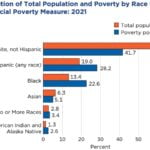Economic security programs, also known as social safety nets, have been vital in efforts to reduce poverty over the past 50 years, according to a Center on Budget and Policy Priorities (CBPP) report published in late November.
CBPP’s report uses the supplemental poverty measure (SPM) to assess poverty rates, which factors in help from government assistance programs that are not included in the official poverty measure calculations used by the U.S. Census Bureau in its annual poverty reports.
These programs – which include Supplemental Nutrition Assistance Program (SNAP) benefits, child tax credits, Social Security and unemployment insurance – are the key drivers of this decrease, CBPP said.
“Some policymakers and pundits have argued that federal anti-poverty programs have failed, noting that the official poverty rate fell sharply between 1959 and 1969 but has changed relatively little since then, apart from fluctuations due to the business cycle,” the report said.
“However, comparing poverty rates in the 1960s and today using the official poverty measure yields misleading results because the official measure doesn’t count non-cash and tax-based benefits like SNAP, the EITC (earned income tax credit) and rental assistance, which now constitute a much larger part of the safety net than 50 years ago, and which most poverty analysts favor including in the poverty measure.”
When safety net programs are removed from the equation, “poverty has improved only modestly over the past five decades, falling from 27% to 25.4% between 1967 and 2017.”
Similar results occur when looking at child poverty, with a reduction of only 3.1% from 1967 to 2017 when government assistance programs are removed from the equation.
When safety net assistance is included in calculations by using the supplemental poverty measure, significant poverty reductions are apparent.
In 1967, 26% of the U.S. was living in poverty based on a calculation using the supplemental poverty measure – a rate that fell to 14.4% by 2017 and 12.8% by 2018. Among children, 28.3% were impoverished in 1967 compared to 13.7% in 2018.
For 2018, CBPP found that without economic poverty programs, an additional 37 million people, including 7 million children, would have been in poverty.
The full report is available here.





